Research Proposal: Social Media Effects on Employee Productivity AU
VerifiedAdded on 2023/06/11
|15
|3877
|271
Project
AI Summary
This research project proposal investigates the effects of social media usage on employee productivity within the Australian university sector. It aims to identify the social media platforms used by employees and their overall impact on productivity. The proposal outlines the research problem, aims, objectives, and research questions, focusing on the relationship between social media use and employee output. It also explores the justification for the research, potential outcomes, and a conceptual framework, including hypotheses related to social media policies and their influence on productivity. The proposal includes a methodology section, secondary data, and a budget and schedule for the research project. It acknowledges the conflicting views on social media's impact, recognizing both its potential for enhancing communication and marketing and its potential for distraction and reduced productivity. The research seeks to provide insights for university management and policymakers in developing effective social media policies.
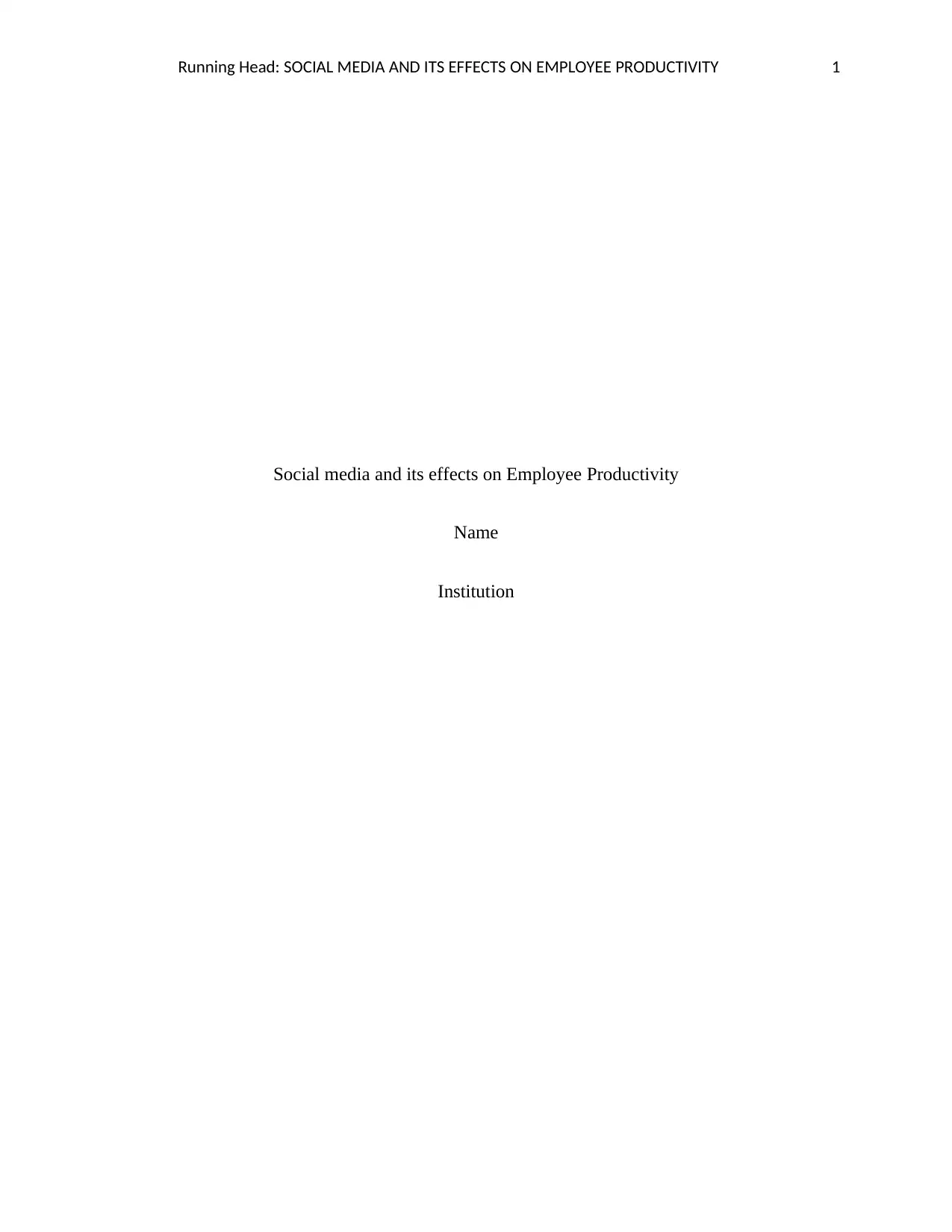
Running Head: SOCIAL MEDIA AND ITS EFFECTS ON EMPLOYEE PRODUCTIVITY 1
Social media and its effects on Employee Productivity
Name
Institution
Social media and its effects on Employee Productivity
Name
Institution
Paraphrase This Document
Need a fresh take? Get an instant paraphrase of this document with our AI Paraphraser
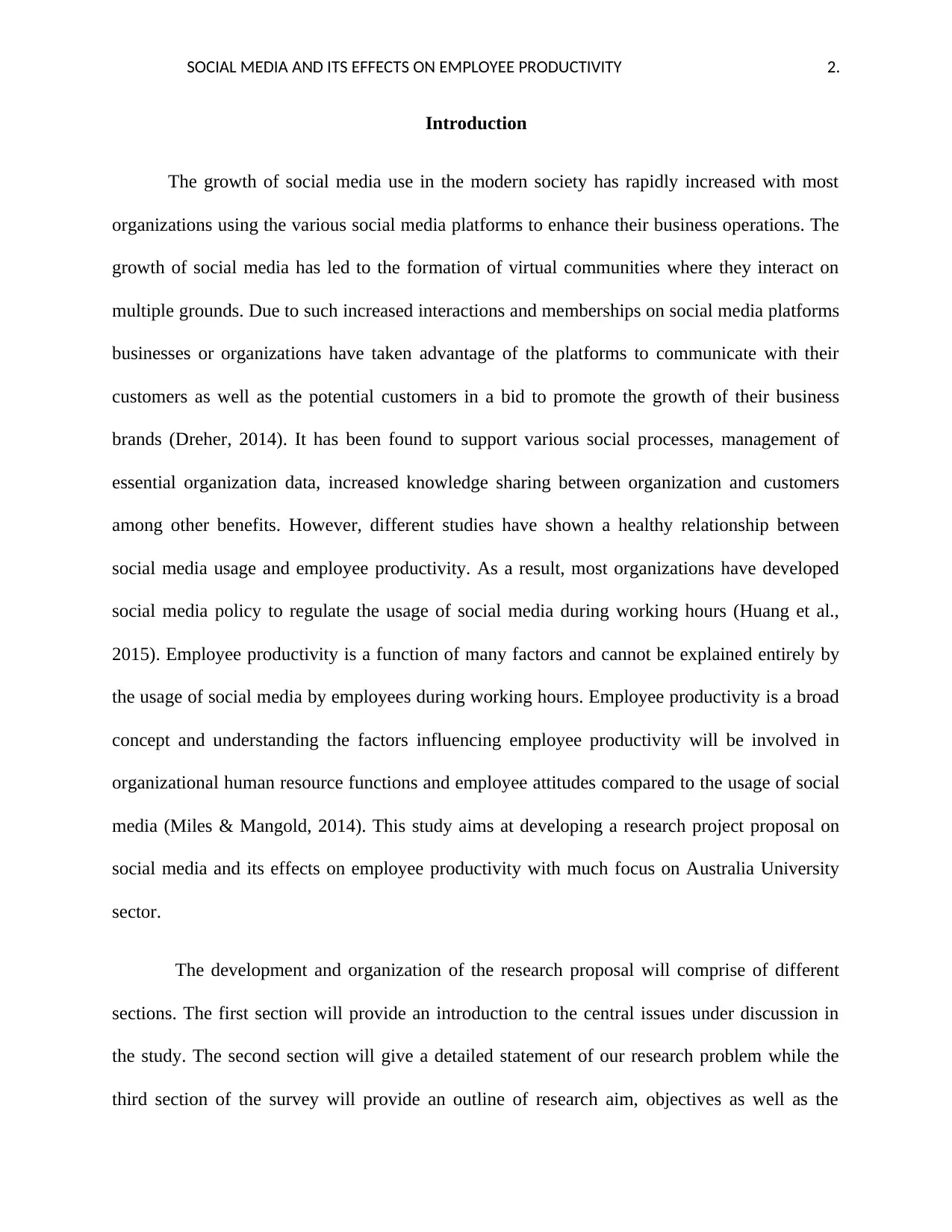
SOCIAL MEDIA AND ITS EFFECTS ON EMPLOYEE PRODUCTIVITY 2.
Introduction
The growth of social media use in the modern society has rapidly increased with most
organizations using the various social media platforms to enhance their business operations. The
growth of social media has led to the formation of virtual communities where they interact on
multiple grounds. Due to such increased interactions and memberships on social media platforms
businesses or organizations have taken advantage of the platforms to communicate with their
customers as well as the potential customers in a bid to promote the growth of their business
brands (Dreher, 2014). It has been found to support various social processes, management of
essential organization data, increased knowledge sharing between organization and customers
among other benefits. However, different studies have shown a healthy relationship between
social media usage and employee productivity. As a result, most organizations have developed
social media policy to regulate the usage of social media during working hours (Huang et al.,
2015). Employee productivity is a function of many factors and cannot be explained entirely by
the usage of social media by employees during working hours. Employee productivity is a broad
concept and understanding the factors influencing employee productivity will be involved in
organizational human resource functions and employee attitudes compared to the usage of social
media (Miles & Mangold, 2014). This study aims at developing a research project proposal on
social media and its effects on employee productivity with much focus on Australia University
sector.
The development and organization of the research proposal will comprise of different
sections. The first section will provide an introduction to the central issues under discussion in
the study. The second section will give a detailed statement of our research problem while the
third section of the survey will provide an outline of research aim, objectives as well as the
Introduction
The growth of social media use in the modern society has rapidly increased with most
organizations using the various social media platforms to enhance their business operations. The
growth of social media has led to the formation of virtual communities where they interact on
multiple grounds. Due to such increased interactions and memberships on social media platforms
businesses or organizations have taken advantage of the platforms to communicate with their
customers as well as the potential customers in a bid to promote the growth of their business
brands (Dreher, 2014). It has been found to support various social processes, management of
essential organization data, increased knowledge sharing between organization and customers
among other benefits. However, different studies have shown a healthy relationship between
social media usage and employee productivity. As a result, most organizations have developed
social media policy to regulate the usage of social media during working hours (Huang et al.,
2015). Employee productivity is a function of many factors and cannot be explained entirely by
the usage of social media by employees during working hours. Employee productivity is a broad
concept and understanding the factors influencing employee productivity will be involved in
organizational human resource functions and employee attitudes compared to the usage of social
media (Miles & Mangold, 2014). This study aims at developing a research project proposal on
social media and its effects on employee productivity with much focus on Australia University
sector.
The development and organization of the research proposal will comprise of different
sections. The first section will provide an introduction to the central issues under discussion in
the study. The second section will give a detailed statement of our research problem while the
third section of the survey will provide an outline of research aim, objectives as well as the
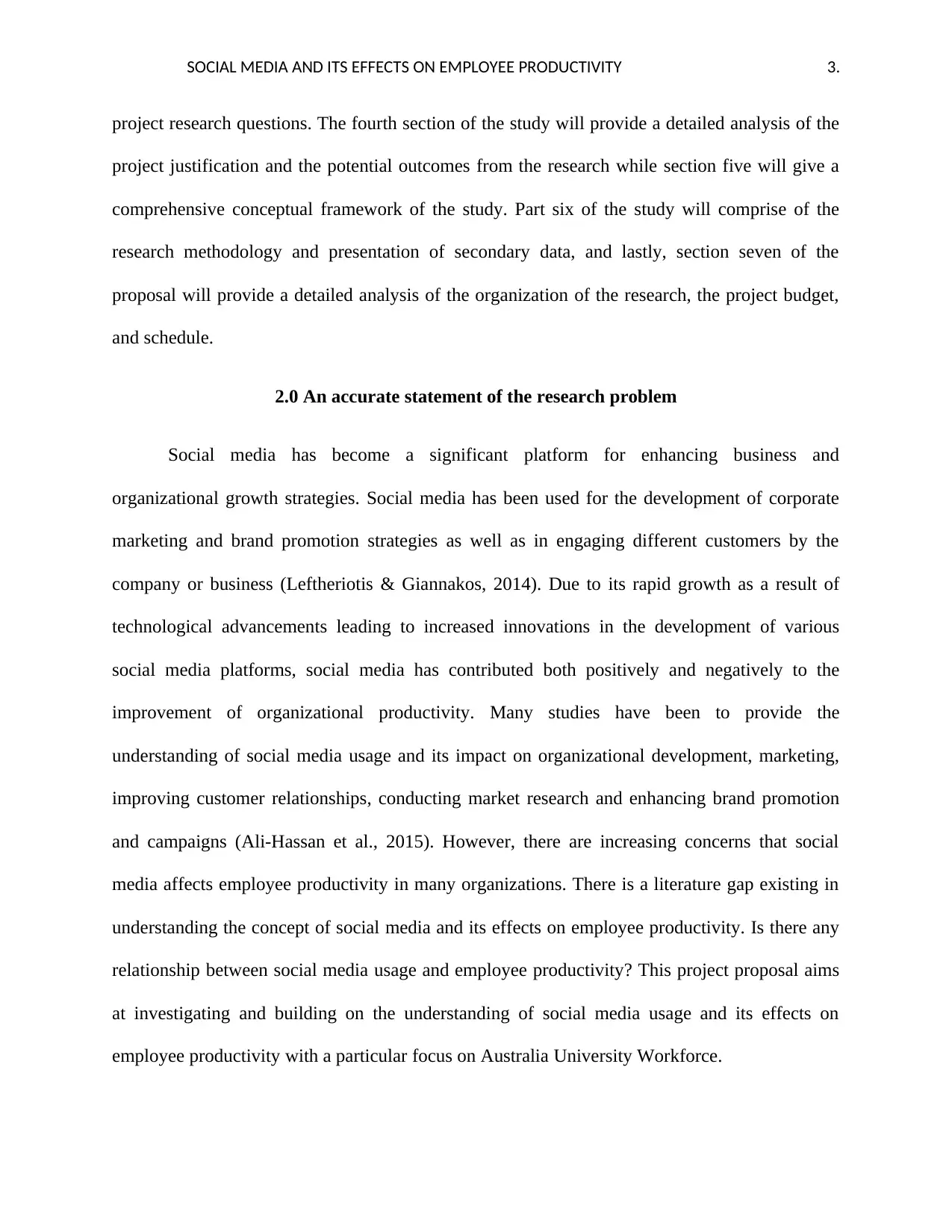
SOCIAL MEDIA AND ITS EFFECTS ON EMPLOYEE PRODUCTIVITY 3.
project research questions. The fourth section of the study will provide a detailed analysis of the
project justification and the potential outcomes from the research while section five will give a
comprehensive conceptual framework of the study. Part six of the study will comprise of the
research methodology and presentation of secondary data, and lastly, section seven of the
proposal will provide a detailed analysis of the organization of the research, the project budget,
and schedule.
2.0 An accurate statement of the research problem
Social media has become a significant platform for enhancing business and
organizational growth strategies. Social media has been used for the development of corporate
marketing and brand promotion strategies as well as in engaging different customers by the
company or business (Leftheriotis & Giannakos, 2014). Due to its rapid growth as a result of
technological advancements leading to increased innovations in the development of various
social media platforms, social media has contributed both positively and negatively to the
improvement of organizational productivity. Many studies have been to provide the
understanding of social media usage and its impact on organizational development, marketing,
improving customer relationships, conducting market research and enhancing brand promotion
and campaigns (Ali-Hassan et al., 2015). However, there are increasing concerns that social
media affects employee productivity in many organizations. There is a literature gap existing in
understanding the concept of social media and its effects on employee productivity. Is there any
relationship between social media usage and employee productivity? This project proposal aims
at investigating and building on the understanding of social media usage and its effects on
employee productivity with a particular focus on Australia University Workforce.
project research questions. The fourth section of the study will provide a detailed analysis of the
project justification and the potential outcomes from the research while section five will give a
comprehensive conceptual framework of the study. Part six of the study will comprise of the
research methodology and presentation of secondary data, and lastly, section seven of the
proposal will provide a detailed analysis of the organization of the research, the project budget,
and schedule.
2.0 An accurate statement of the research problem
Social media has become a significant platform for enhancing business and
organizational growth strategies. Social media has been used for the development of corporate
marketing and brand promotion strategies as well as in engaging different customers by the
company or business (Leftheriotis & Giannakos, 2014). Due to its rapid growth as a result of
technological advancements leading to increased innovations in the development of various
social media platforms, social media has contributed both positively and negatively to the
improvement of organizational productivity. Many studies have been to provide the
understanding of social media usage and its impact on organizational development, marketing,
improving customer relationships, conducting market research and enhancing brand promotion
and campaigns (Ali-Hassan et al., 2015). However, there are increasing concerns that social
media affects employee productivity in many organizations. There is a literature gap existing in
understanding the concept of social media and its effects on employee productivity. Is there any
relationship between social media usage and employee productivity? This project proposal aims
at investigating and building on the understanding of social media usage and its effects on
employee productivity with a particular focus on Australia University Workforce.
⊘ This is a preview!⊘
Do you want full access?
Subscribe today to unlock all pages.

Trusted by 1+ million students worldwide
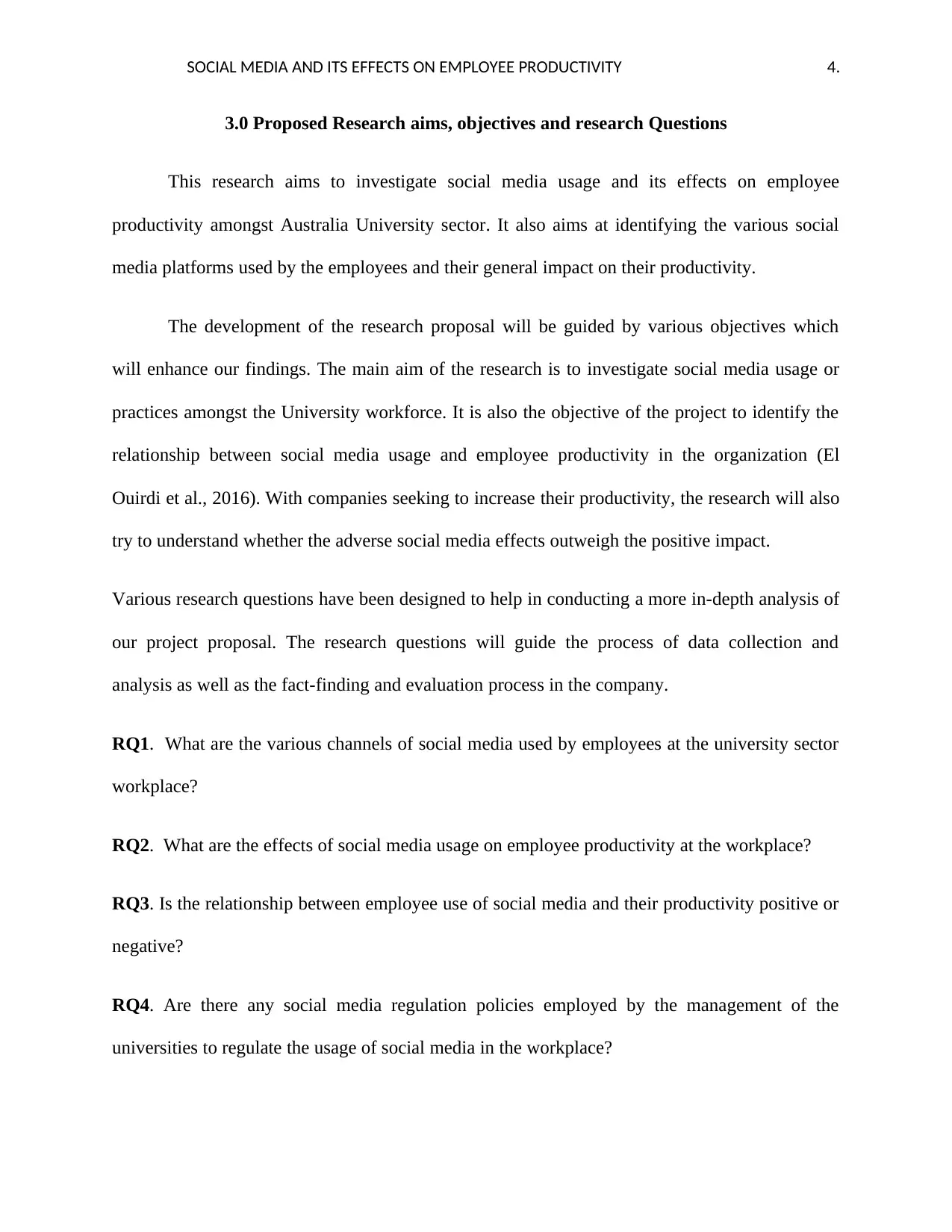
SOCIAL MEDIA AND ITS EFFECTS ON EMPLOYEE PRODUCTIVITY 4.
3.0 Proposed Research aims, objectives and research Questions
This research aims to investigate social media usage and its effects on employee
productivity amongst Australia University sector. It also aims at identifying the various social
media platforms used by the employees and their general impact on their productivity.
The development of the research proposal will be guided by various objectives which
will enhance our findings. The main aim of the research is to investigate social media usage or
practices amongst the University workforce. It is also the objective of the project to identify the
relationship between social media usage and employee productivity in the organization (El
Ouirdi et al., 2016). With companies seeking to increase their productivity, the research will also
try to understand whether the adverse social media effects outweigh the positive impact.
Various research questions have been designed to help in conducting a more in-depth analysis of
our project proposal. The research questions will guide the process of data collection and
analysis as well as the fact-finding and evaluation process in the company.
RQ1. What are the various channels of social media used by employees at the university sector
workplace?
RQ2. What are the effects of social media usage on employee productivity at the workplace?
RQ3. Is the relationship between employee use of social media and their productivity positive or
negative?
RQ4. Are there any social media regulation policies employed by the management of the
universities to regulate the usage of social media in the workplace?
3.0 Proposed Research aims, objectives and research Questions
This research aims to investigate social media usage and its effects on employee
productivity amongst Australia University sector. It also aims at identifying the various social
media platforms used by the employees and their general impact on their productivity.
The development of the research proposal will be guided by various objectives which
will enhance our findings. The main aim of the research is to investigate social media usage or
practices amongst the University workforce. It is also the objective of the project to identify the
relationship between social media usage and employee productivity in the organization (El
Ouirdi et al., 2016). With companies seeking to increase their productivity, the research will also
try to understand whether the adverse social media effects outweigh the positive impact.
Various research questions have been designed to help in conducting a more in-depth analysis of
our project proposal. The research questions will guide the process of data collection and
analysis as well as the fact-finding and evaluation process in the company.
RQ1. What are the various channels of social media used by employees at the university sector
workplace?
RQ2. What are the effects of social media usage on employee productivity at the workplace?
RQ3. Is the relationship between employee use of social media and their productivity positive or
negative?
RQ4. Are there any social media regulation policies employed by the management of the
universities to regulate the usage of social media in the workplace?
Paraphrase This Document
Need a fresh take? Get an instant paraphrase of this document with our AI Paraphraser
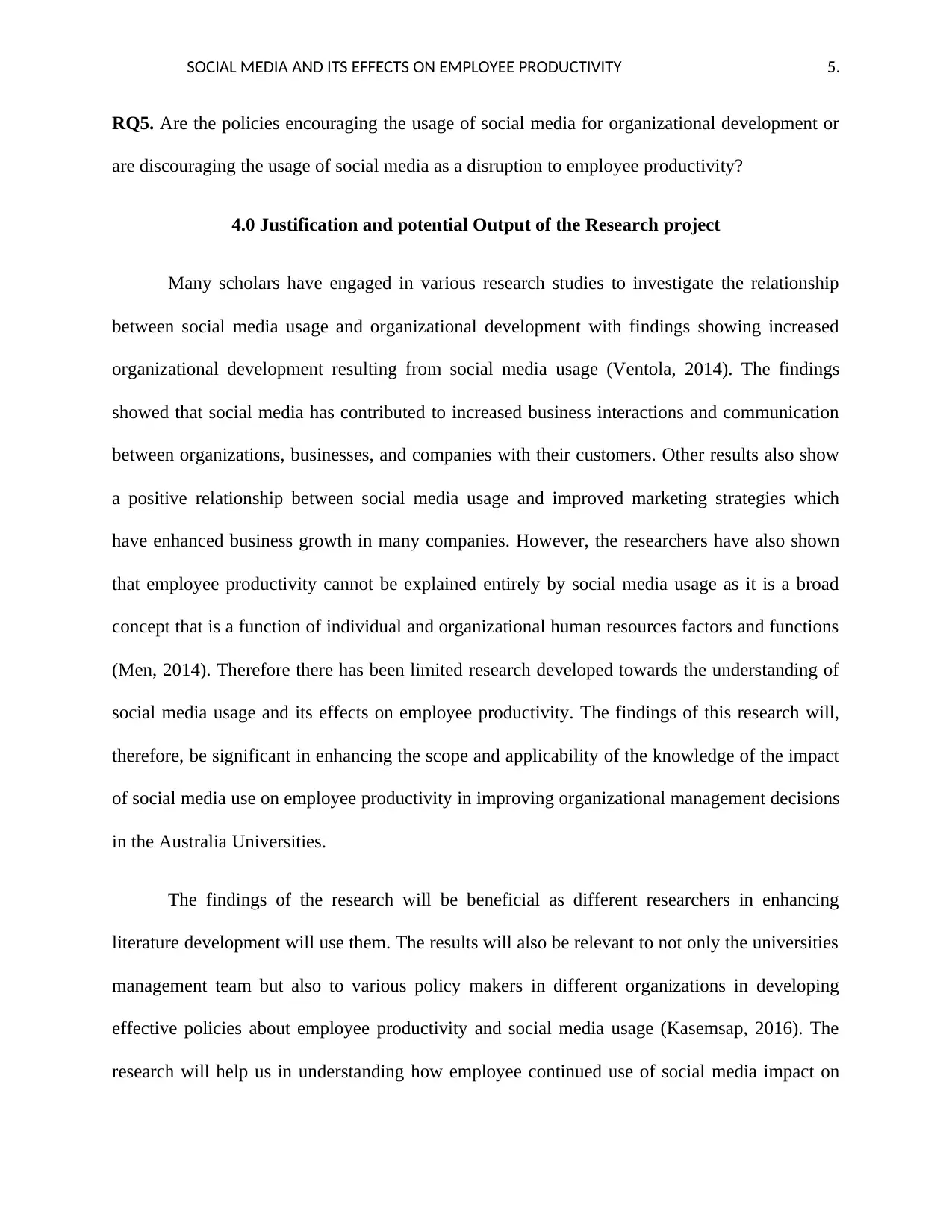
SOCIAL MEDIA AND ITS EFFECTS ON EMPLOYEE PRODUCTIVITY 5.
RQ5. Are the policies encouraging the usage of social media for organizational development or
are discouraging the usage of social media as a disruption to employee productivity?
4.0 Justification and potential Output of the Research project
Many scholars have engaged in various research studies to investigate the relationship
between social media usage and organizational development with findings showing increased
organizational development resulting from social media usage (Ventola, 2014). The findings
showed that social media has contributed to increased business interactions and communication
between organizations, businesses, and companies with their customers. Other results also show
a positive relationship between social media usage and improved marketing strategies which
have enhanced business growth in many companies. However, the researchers have also shown
that employee productivity cannot be explained entirely by social media usage as it is a broad
concept that is a function of individual and organizational human resources factors and functions
(Men, 2014). Therefore there has been limited research developed towards the understanding of
social media usage and its effects on employee productivity. The findings of this research will,
therefore, be significant in enhancing the scope and applicability of the knowledge of the impact
of social media use on employee productivity in improving organizational management decisions
in the Australia Universities.
The findings of the research will be beneficial as different researchers in enhancing
literature development will use them. The results will also be relevant to not only the universities
management team but also to various policy makers in different organizations in developing
effective policies about employee productivity and social media usage (Kasemsap, 2016). The
research will help us in understanding how employee continued use of social media impact on
RQ5. Are the policies encouraging the usage of social media for organizational development or
are discouraging the usage of social media as a disruption to employee productivity?
4.0 Justification and potential Output of the Research project
Many scholars have engaged in various research studies to investigate the relationship
between social media usage and organizational development with findings showing increased
organizational development resulting from social media usage (Ventola, 2014). The findings
showed that social media has contributed to increased business interactions and communication
between organizations, businesses, and companies with their customers. Other results also show
a positive relationship between social media usage and improved marketing strategies which
have enhanced business growth in many companies. However, the researchers have also shown
that employee productivity cannot be explained entirely by social media usage as it is a broad
concept that is a function of individual and organizational human resources factors and functions
(Men, 2014). Therefore there has been limited research developed towards the understanding of
social media usage and its effects on employee productivity. The findings of this research will,
therefore, be significant in enhancing the scope and applicability of the knowledge of the impact
of social media use on employee productivity in improving organizational management decisions
in the Australia Universities.
The findings of the research will be beneficial as different researchers in enhancing
literature development will use them. The results will also be relevant to not only the universities
management team but also to various policy makers in different organizations in developing
effective policies about employee productivity and social media usage (Kasemsap, 2016). The
research will help us in understanding how employee continued use of social media impact on
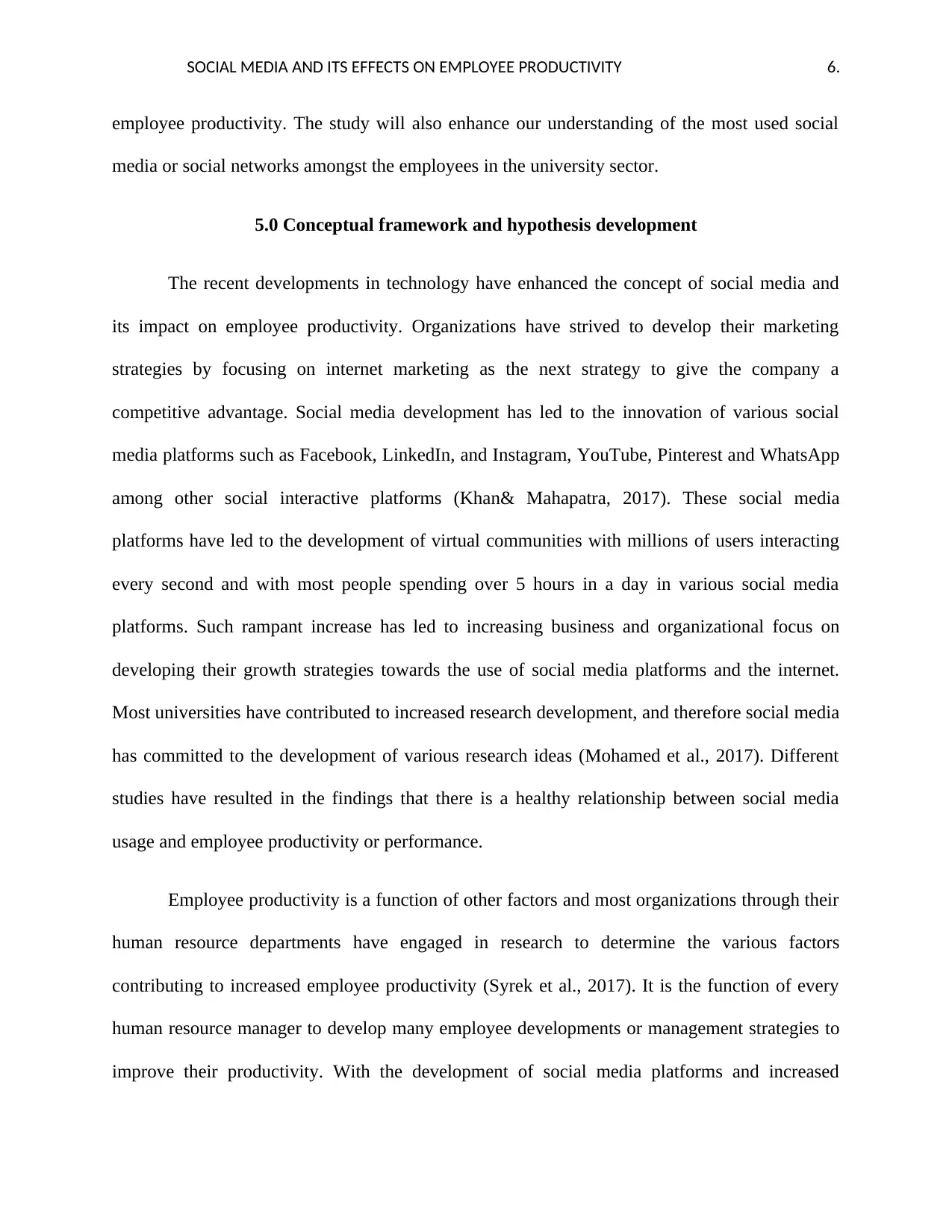
SOCIAL MEDIA AND ITS EFFECTS ON EMPLOYEE PRODUCTIVITY 6.
employee productivity. The study will also enhance our understanding of the most used social
media or social networks amongst the employees in the university sector.
5.0 Conceptual framework and hypothesis development
The recent developments in technology have enhanced the concept of social media and
its impact on employee productivity. Organizations have strived to develop their marketing
strategies by focusing on internet marketing as the next strategy to give the company a
competitive advantage. Social media development has led to the innovation of various social
media platforms such as Facebook, LinkedIn, and Instagram, YouTube, Pinterest and WhatsApp
among other social interactive platforms (Khan& Mahapatra, 2017). These social media
platforms have led to the development of virtual communities with millions of users interacting
every second and with most people spending over 5 hours in a day in various social media
platforms. Such rampant increase has led to increasing business and organizational focus on
developing their growth strategies towards the use of social media platforms and the internet.
Most universities have contributed to increased research development, and therefore social media
has committed to the development of various research ideas (Mohamed et al., 2017). Different
studies have resulted in the findings that there is a healthy relationship between social media
usage and employee productivity or performance.
Employee productivity is a function of other factors and most organizations through their
human resource departments have engaged in research to determine the various factors
contributing to increased employee productivity (Syrek et al., 2017). It is the function of every
human resource manager to develop many employee developments or management strategies to
improve their productivity. With the development of social media platforms and increased
employee productivity. The study will also enhance our understanding of the most used social
media or social networks amongst the employees in the university sector.
5.0 Conceptual framework and hypothesis development
The recent developments in technology have enhanced the concept of social media and
its impact on employee productivity. Organizations have strived to develop their marketing
strategies by focusing on internet marketing as the next strategy to give the company a
competitive advantage. Social media development has led to the innovation of various social
media platforms such as Facebook, LinkedIn, and Instagram, YouTube, Pinterest and WhatsApp
among other social interactive platforms (Khan& Mahapatra, 2017). These social media
platforms have led to the development of virtual communities with millions of users interacting
every second and with most people spending over 5 hours in a day in various social media
platforms. Such rampant increase has led to increasing business and organizational focus on
developing their growth strategies towards the use of social media platforms and the internet.
Most universities have contributed to increased research development, and therefore social media
has committed to the development of various research ideas (Mohamed et al., 2017). Different
studies have resulted in the findings that there is a healthy relationship between social media
usage and employee productivity or performance.
Employee productivity is a function of other factors and most organizations through their
human resource departments have engaged in research to determine the various factors
contributing to increased employee productivity (Syrek et al., 2017). It is the function of every
human resource manager to develop many employee developments or management strategies to
improve their productivity. With the development of social media platforms and increased
⊘ This is a preview!⊘
Do you want full access?
Subscribe today to unlock all pages.

Trusted by 1+ million students worldwide
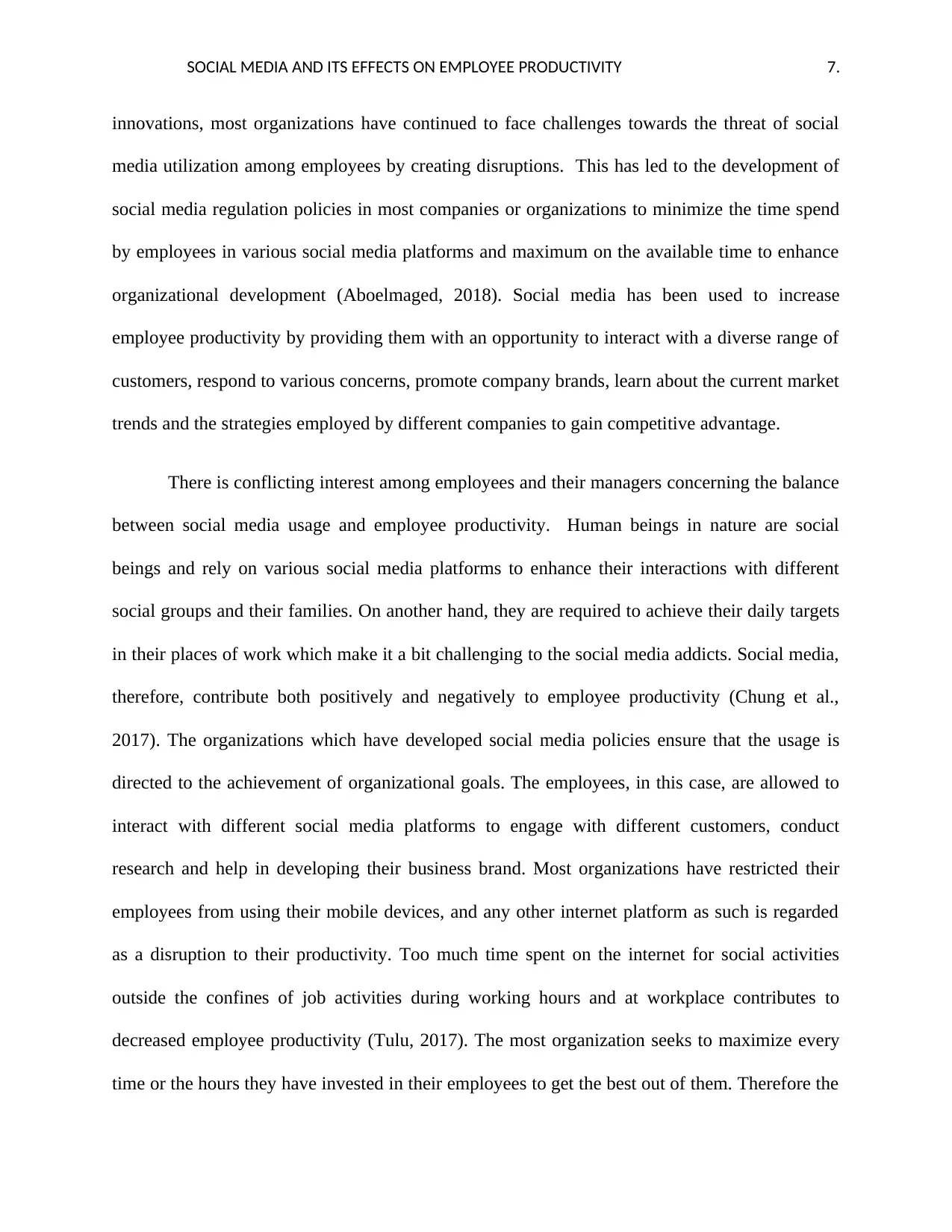
SOCIAL MEDIA AND ITS EFFECTS ON EMPLOYEE PRODUCTIVITY 7.
innovations, most organizations have continued to face challenges towards the threat of social
media utilization among employees by creating disruptions. This has led to the development of
social media regulation policies in most companies or organizations to minimize the time spend
by employees in various social media platforms and maximum on the available time to enhance
organizational development (Aboelmaged, 2018). Social media has been used to increase
employee productivity by providing them with an opportunity to interact with a diverse range of
customers, respond to various concerns, promote company brands, learn about the current market
trends and the strategies employed by different companies to gain competitive advantage.
There is conflicting interest among employees and their managers concerning the balance
between social media usage and employee productivity. Human beings in nature are social
beings and rely on various social media platforms to enhance their interactions with different
social groups and their families. On another hand, they are required to achieve their daily targets
in their places of work which make it a bit challenging to the social media addicts. Social media,
therefore, contribute both positively and negatively to employee productivity (Chung et al.,
2017). The organizations which have developed social media policies ensure that the usage is
directed to the achievement of organizational goals. The employees, in this case, are allowed to
interact with different social media platforms to engage with different customers, conduct
research and help in developing their business brand. Most organizations have restricted their
employees from using their mobile devices, and any other internet platform as such is regarded
as a disruption to their productivity. Too much time spent on the internet for social activities
outside the confines of job activities during working hours and at workplace contributes to
decreased employee productivity (Tulu, 2017). The most organization seeks to maximize every
time or the hours they have invested in their employees to get the best out of them. Therefore the
innovations, most organizations have continued to face challenges towards the threat of social
media utilization among employees by creating disruptions. This has led to the development of
social media regulation policies in most companies or organizations to minimize the time spend
by employees in various social media platforms and maximum on the available time to enhance
organizational development (Aboelmaged, 2018). Social media has been used to increase
employee productivity by providing them with an opportunity to interact with a diverse range of
customers, respond to various concerns, promote company brands, learn about the current market
trends and the strategies employed by different companies to gain competitive advantage.
There is conflicting interest among employees and their managers concerning the balance
between social media usage and employee productivity. Human beings in nature are social
beings and rely on various social media platforms to enhance their interactions with different
social groups and their families. On another hand, they are required to achieve their daily targets
in their places of work which make it a bit challenging to the social media addicts. Social media,
therefore, contribute both positively and negatively to employee productivity (Chung et al.,
2017). The organizations which have developed social media policies ensure that the usage is
directed to the achievement of organizational goals. The employees, in this case, are allowed to
interact with different social media platforms to engage with different customers, conduct
research and help in developing their business brand. Most organizations have restricted their
employees from using their mobile devices, and any other internet platform as such is regarded
as a disruption to their productivity. Too much time spent on the internet for social activities
outside the confines of job activities during working hours and at workplace contributes to
decreased employee productivity (Tulu, 2017). The most organization seeks to maximize every
time or the hours they have invested in their employees to get the best out of them. Therefore the
Paraphrase This Document
Need a fresh take? Get an instant paraphrase of this document with our AI Paraphraser
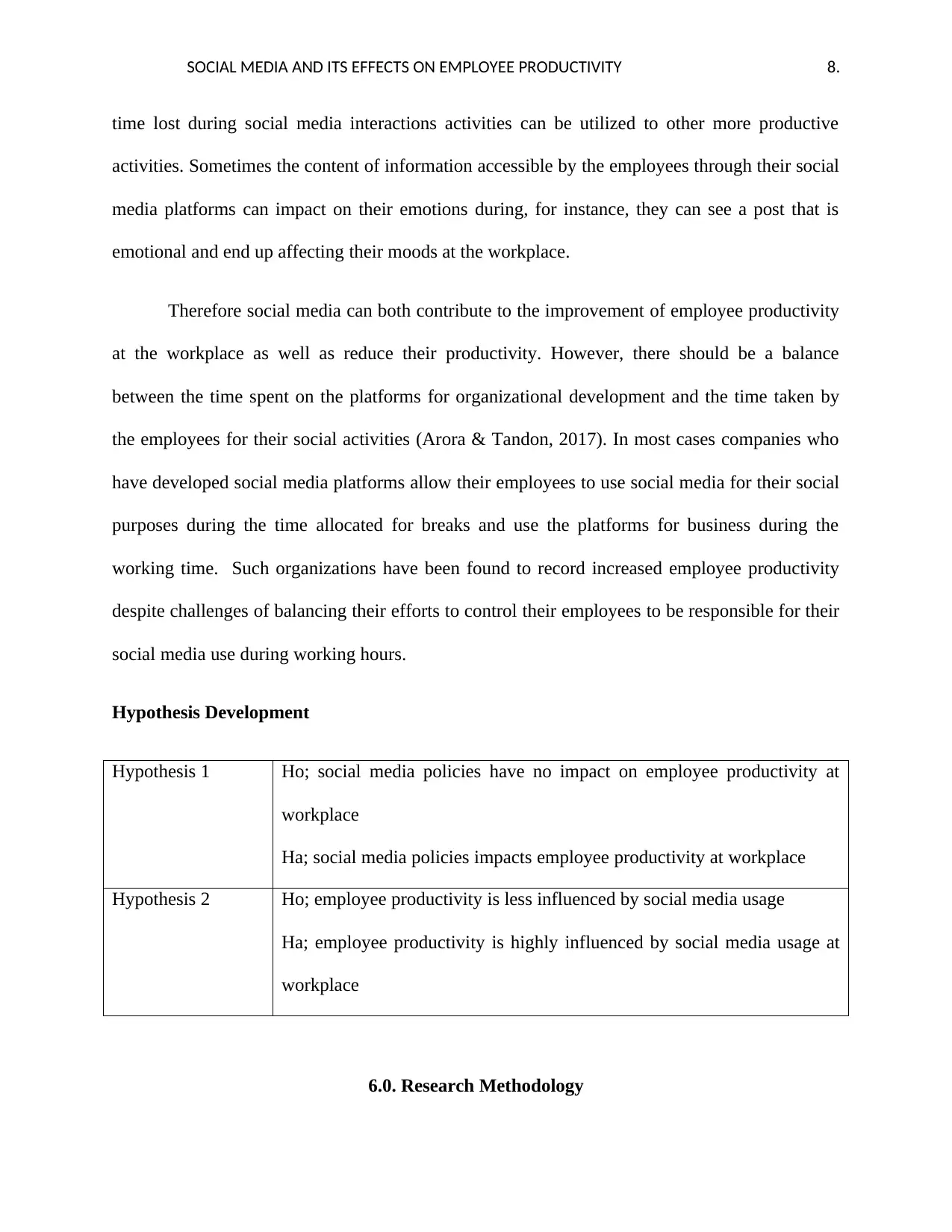
SOCIAL MEDIA AND ITS EFFECTS ON EMPLOYEE PRODUCTIVITY 8.
time lost during social media interactions activities can be utilized to other more productive
activities. Sometimes the content of information accessible by the employees through their social
media platforms can impact on their emotions during, for instance, they can see a post that is
emotional and end up affecting their moods at the workplace.
Therefore social media can both contribute to the improvement of employee productivity
at the workplace as well as reduce their productivity. However, there should be a balance
between the time spent on the platforms for organizational development and the time taken by
the employees for their social activities (Arora & Tandon, 2017). In most cases companies who
have developed social media platforms allow their employees to use social media for their social
purposes during the time allocated for breaks and use the platforms for business during the
working time. Such organizations have been found to record increased employee productivity
despite challenges of balancing their efforts to control their employees to be responsible for their
social media use during working hours.
Hypothesis Development
Hypothesis 1 Ho; social media policies have no impact on employee productivity at
workplace
Ha; social media policies impacts employee productivity at workplace
Hypothesis 2 Ho; employee productivity is less influenced by social media usage
Ha; employee productivity is highly influenced by social media usage at
workplace
6.0. Research Methodology
time lost during social media interactions activities can be utilized to other more productive
activities. Sometimes the content of information accessible by the employees through their social
media platforms can impact on their emotions during, for instance, they can see a post that is
emotional and end up affecting their moods at the workplace.
Therefore social media can both contribute to the improvement of employee productivity
at the workplace as well as reduce their productivity. However, there should be a balance
between the time spent on the platforms for organizational development and the time taken by
the employees for their social activities (Arora & Tandon, 2017). In most cases companies who
have developed social media platforms allow their employees to use social media for their social
purposes during the time allocated for breaks and use the platforms for business during the
working time. Such organizations have been found to record increased employee productivity
despite challenges of balancing their efforts to control their employees to be responsible for their
social media use during working hours.
Hypothesis Development
Hypothesis 1 Ho; social media policies have no impact on employee productivity at
workplace
Ha; social media policies impacts employee productivity at workplace
Hypothesis 2 Ho; employee productivity is less influenced by social media usage
Ha; employee productivity is highly influenced by social media usage at
workplace
6.0. Research Methodology
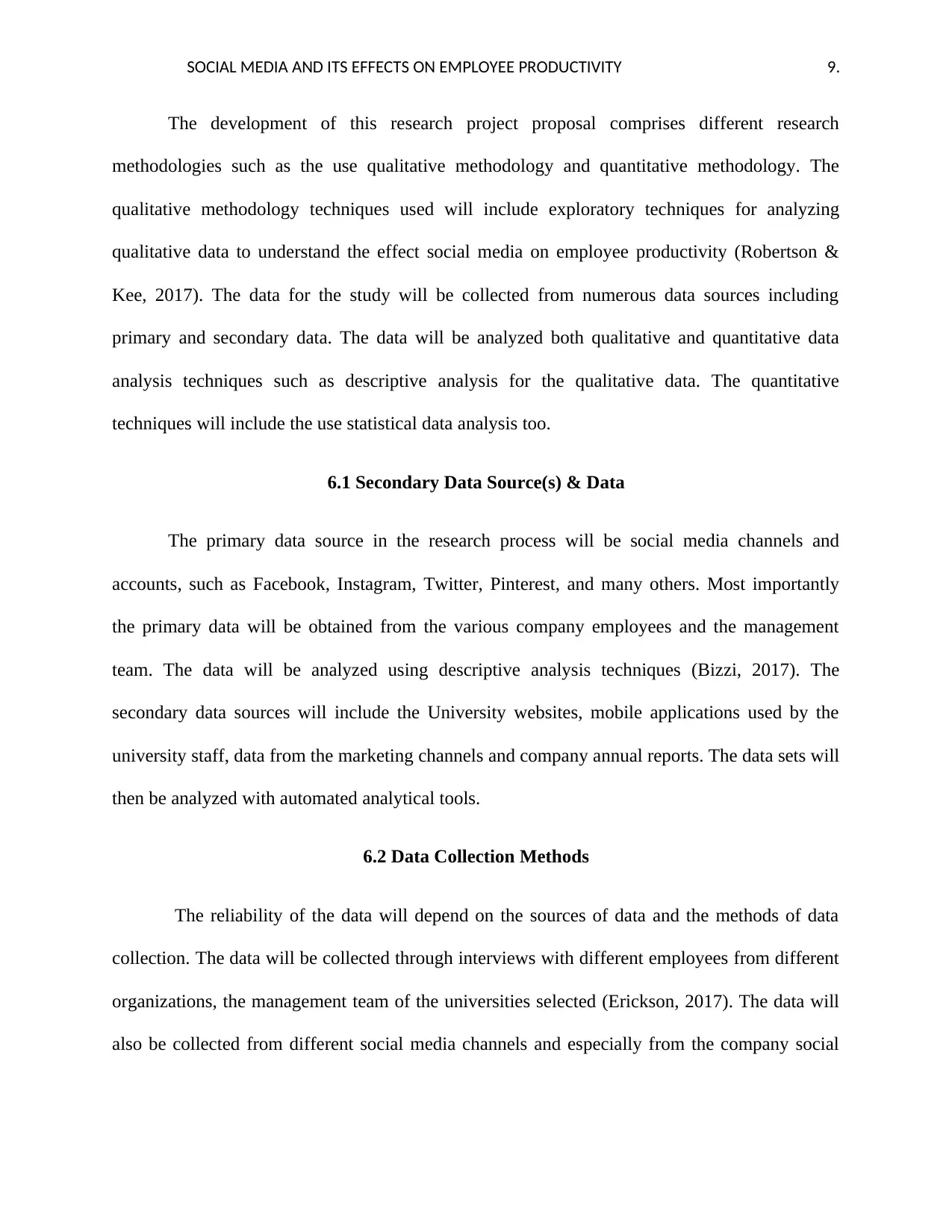
SOCIAL MEDIA AND ITS EFFECTS ON EMPLOYEE PRODUCTIVITY 9.
The development of this research project proposal comprises different research
methodologies such as the use qualitative methodology and quantitative methodology. The
qualitative methodology techniques used will include exploratory techniques for analyzing
qualitative data to understand the effect social media on employee productivity (Robertson &
Kee, 2017). The data for the study will be collected from numerous data sources including
primary and secondary data. The data will be analyzed both qualitative and quantitative data
analysis techniques such as descriptive analysis for the qualitative data. The quantitative
techniques will include the use statistical data analysis too.
6.1 Secondary Data Source(s) & Data
The primary data source in the research process will be social media channels and
accounts, such as Facebook, Instagram, Twitter, Pinterest, and many others. Most importantly
the primary data will be obtained from the various company employees and the management
team. The data will be analyzed using descriptive analysis techniques (Bizzi, 2017). The
secondary data sources will include the University websites, mobile applications used by the
university staff, data from the marketing channels and company annual reports. The data sets will
then be analyzed with automated analytical tools.
6.2 Data Collection Methods
The reliability of the data will depend on the sources of data and the methods of data
collection. The data will be collected through interviews with different employees from different
organizations, the management team of the universities selected (Erickson, 2017). The data will
also be collected from different social media channels and especially from the company social
The development of this research project proposal comprises different research
methodologies such as the use qualitative methodology and quantitative methodology. The
qualitative methodology techniques used will include exploratory techniques for analyzing
qualitative data to understand the effect social media on employee productivity (Robertson &
Kee, 2017). The data for the study will be collected from numerous data sources including
primary and secondary data. The data will be analyzed both qualitative and quantitative data
analysis techniques such as descriptive analysis for the qualitative data. The quantitative
techniques will include the use statistical data analysis too.
6.1 Secondary Data Source(s) & Data
The primary data source in the research process will be social media channels and
accounts, such as Facebook, Instagram, Twitter, Pinterest, and many others. Most importantly
the primary data will be obtained from the various company employees and the management
team. The data will be analyzed using descriptive analysis techniques (Bizzi, 2017). The
secondary data sources will include the University websites, mobile applications used by the
university staff, data from the marketing channels and company annual reports. The data sets will
then be analyzed with automated analytical tools.
6.2 Data Collection Methods
The reliability of the data will depend on the sources of data and the methods of data
collection. The data will be collected through interviews with different employees from different
organizations, the management team of the universities selected (Erickson, 2017). The data will
also be collected from different social media channels and especially from the company social
⊘ This is a preview!⊘
Do you want full access?
Subscribe today to unlock all pages.

Trusted by 1+ million students worldwide
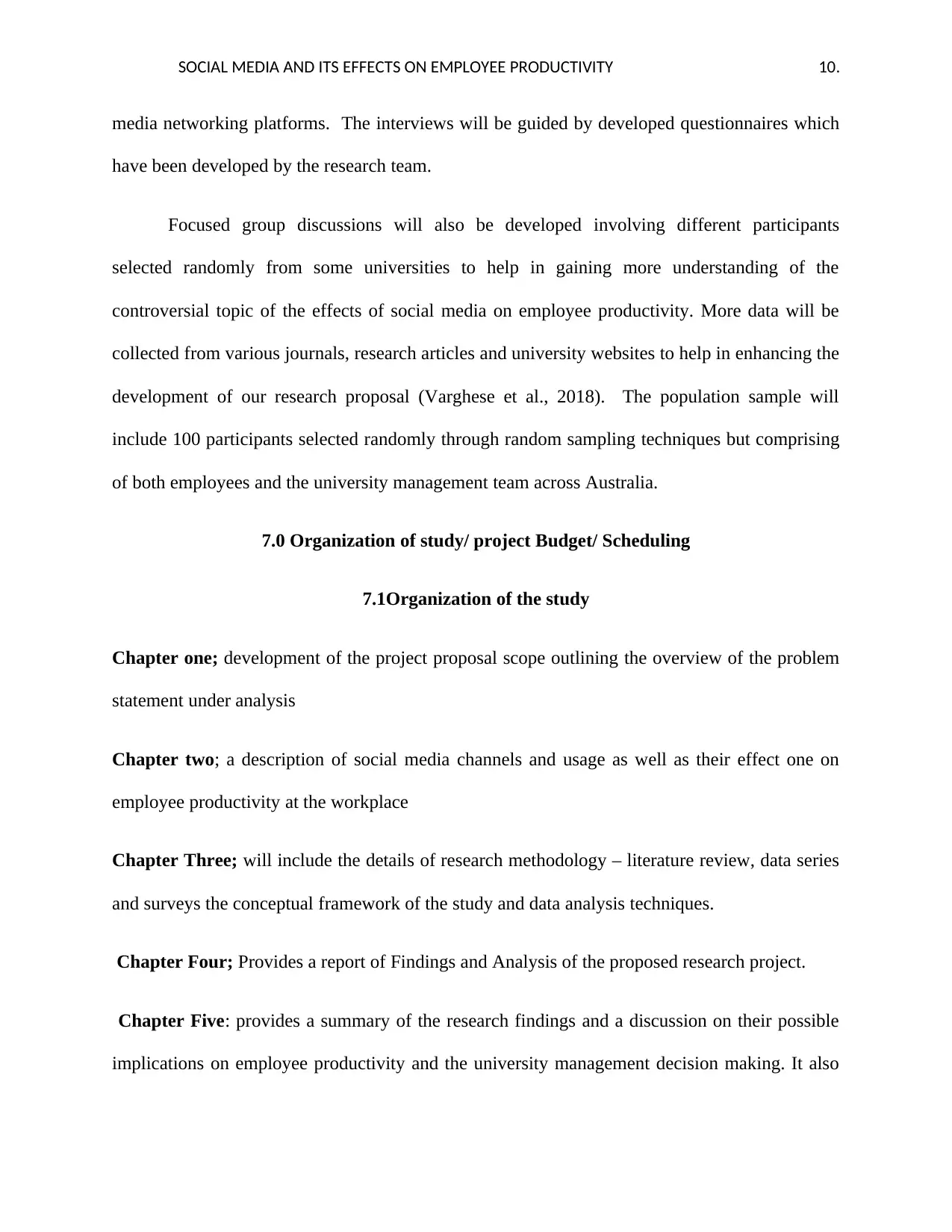
SOCIAL MEDIA AND ITS EFFECTS ON EMPLOYEE PRODUCTIVITY 10.
media networking platforms. The interviews will be guided by developed questionnaires which
have been developed by the research team.
Focused group discussions will also be developed involving different participants
selected randomly from some universities to help in gaining more understanding of the
controversial topic of the effects of social media on employee productivity. More data will be
collected from various journals, research articles and university websites to help in enhancing the
development of our research proposal (Varghese et al., 2018). The population sample will
include 100 participants selected randomly through random sampling techniques but comprising
of both employees and the university management team across Australia.
7.0 Organization of study/ project Budget/ Scheduling
7.1Organization of the study
Chapter one; development of the project proposal scope outlining the overview of the problem
statement under analysis
Chapter two; a description of social media channels and usage as well as their effect one on
employee productivity at the workplace
Chapter Three; will include the details of research methodology – literature review, data series
and surveys the conceptual framework of the study and data analysis techniques.
Chapter Four; Provides a report of Findings and Analysis of the proposed research project.
Chapter Five: provides a summary of the research findings and a discussion on their possible
implications on employee productivity and the university management decision making. It also
media networking platforms. The interviews will be guided by developed questionnaires which
have been developed by the research team.
Focused group discussions will also be developed involving different participants
selected randomly from some universities to help in gaining more understanding of the
controversial topic of the effects of social media on employee productivity. More data will be
collected from various journals, research articles and university websites to help in enhancing the
development of our research proposal (Varghese et al., 2018). The population sample will
include 100 participants selected randomly through random sampling techniques but comprising
of both employees and the university management team across Australia.
7.0 Organization of study/ project Budget/ Scheduling
7.1Organization of the study
Chapter one; development of the project proposal scope outlining the overview of the problem
statement under analysis
Chapter two; a description of social media channels and usage as well as their effect one on
employee productivity at the workplace
Chapter Three; will include the details of research methodology – literature review, data series
and surveys the conceptual framework of the study and data analysis techniques.
Chapter Four; Provides a report of Findings and Analysis of the proposed research project.
Chapter Five: provides a summary of the research findings and a discussion on their possible
implications on employee productivity and the university management decision making. It also
Paraphrase This Document
Need a fresh take? Get an instant paraphrase of this document with our AI Paraphraser
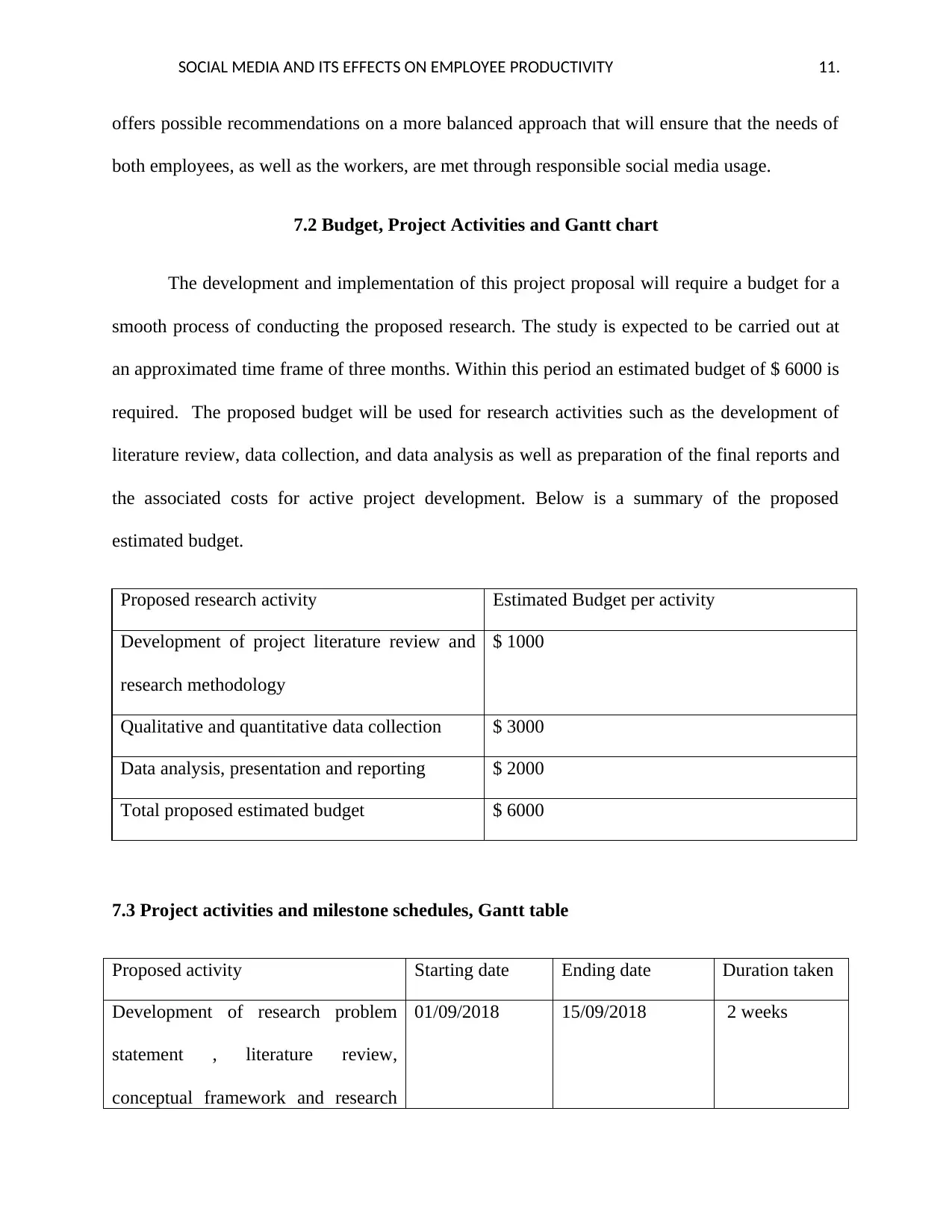
SOCIAL MEDIA AND ITS EFFECTS ON EMPLOYEE PRODUCTIVITY 11.
offers possible recommendations on a more balanced approach that will ensure that the needs of
both employees, as well as the workers, are met through responsible social media usage.
7.2 Budget, Project Activities and Gantt chart
The development and implementation of this project proposal will require a budget for a
smooth process of conducting the proposed research. The study is expected to be carried out at
an approximated time frame of three months. Within this period an estimated budget of $ 6000 is
required. The proposed budget will be used for research activities such as the development of
literature review, data collection, and data analysis as well as preparation of the final reports and
the associated costs for active project development. Below is a summary of the proposed
estimated budget.
Proposed research activity Estimated Budget per activity
Development of project literature review and
research methodology
$ 1000
Qualitative and quantitative data collection $ 3000
Data analysis, presentation and reporting $ 2000
Total proposed estimated budget $ 6000
7.3 Project activities and milestone schedules, Gantt table
Proposed activity Starting date Ending date Duration taken
Development of research problem
statement , literature review,
conceptual framework and research
01/09/2018 15/09/2018 2 weeks
offers possible recommendations on a more balanced approach that will ensure that the needs of
both employees, as well as the workers, are met through responsible social media usage.
7.2 Budget, Project Activities and Gantt chart
The development and implementation of this project proposal will require a budget for a
smooth process of conducting the proposed research. The study is expected to be carried out at
an approximated time frame of three months. Within this period an estimated budget of $ 6000 is
required. The proposed budget will be used for research activities such as the development of
literature review, data collection, and data analysis as well as preparation of the final reports and
the associated costs for active project development. Below is a summary of the proposed
estimated budget.
Proposed research activity Estimated Budget per activity
Development of project literature review and
research methodology
$ 1000
Qualitative and quantitative data collection $ 3000
Data analysis, presentation and reporting $ 2000
Total proposed estimated budget $ 6000
7.3 Project activities and milestone schedules, Gantt table
Proposed activity Starting date Ending date Duration taken
Development of research problem
statement , literature review,
conceptual framework and research
01/09/2018 15/09/2018 2 weeks
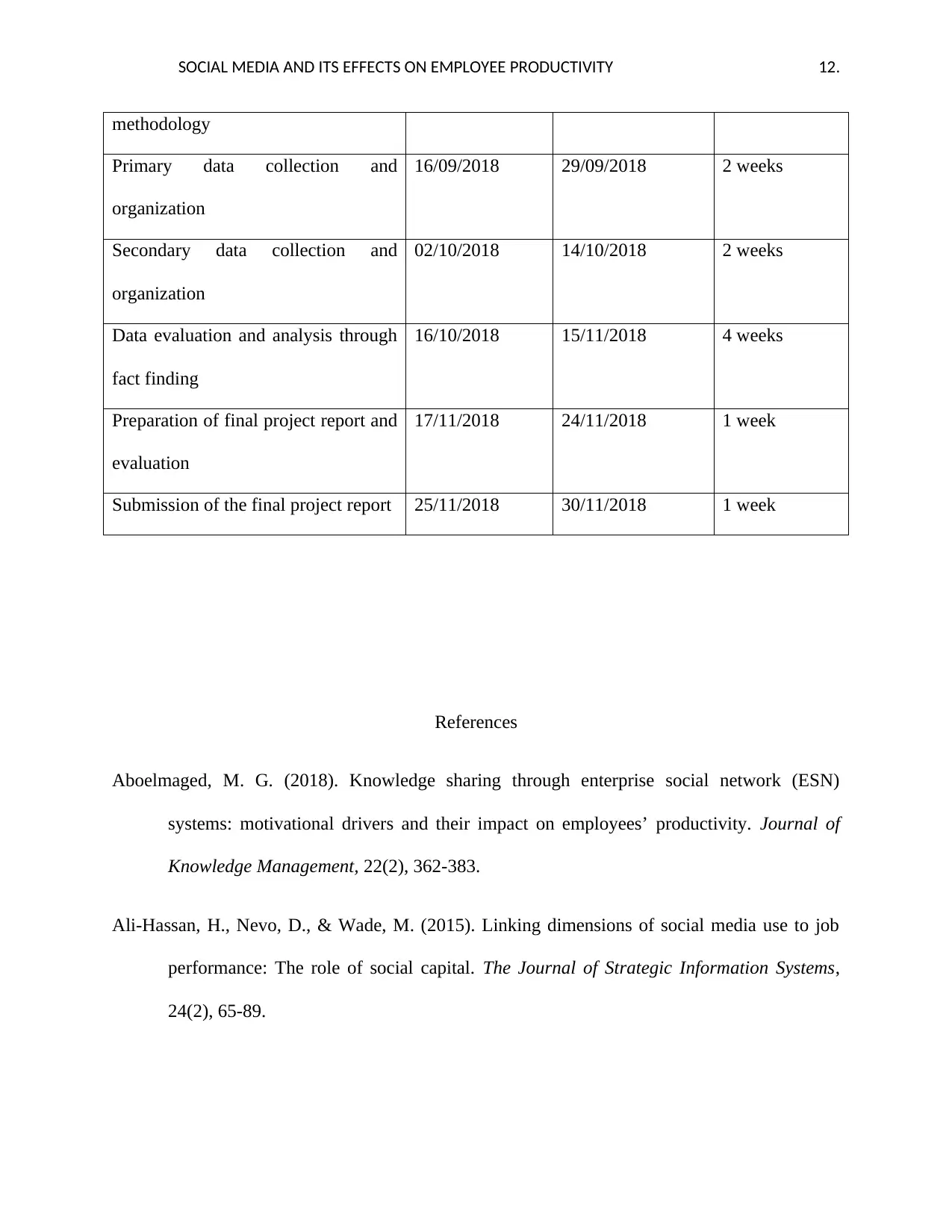
SOCIAL MEDIA AND ITS EFFECTS ON EMPLOYEE PRODUCTIVITY 12.
methodology
Primary data collection and
organization
16/09/2018 29/09/2018 2 weeks
Secondary data collection and
organization
02/10/2018 14/10/2018 2 weeks
Data evaluation and analysis through
fact finding
16/10/2018 15/11/2018 4 weeks
Preparation of final project report and
evaluation
17/11/2018 24/11/2018 1 week
Submission of the final project report 25/11/2018 30/11/2018 1 week
References
Aboelmaged, M. G. (2018). Knowledge sharing through enterprise social network (ESN)
systems: motivational drivers and their impact on employees’ productivity. Journal of
Knowledge Management, 22(2), 362-383.
Ali-Hassan, H., Nevo, D., & Wade, M. (2015). Linking dimensions of social media use to job
performance: The role of social capital. The Journal of Strategic Information Systems,
24(2), 65-89.
methodology
Primary data collection and
organization
16/09/2018 29/09/2018 2 weeks
Secondary data collection and
organization
02/10/2018 14/10/2018 2 weeks
Data evaluation and analysis through
fact finding
16/10/2018 15/11/2018 4 weeks
Preparation of final project report and
evaluation
17/11/2018 24/11/2018 1 week
Submission of the final project report 25/11/2018 30/11/2018 1 week
References
Aboelmaged, M. G. (2018). Knowledge sharing through enterprise social network (ESN)
systems: motivational drivers and their impact on employees’ productivity. Journal of
Knowledge Management, 22(2), 362-383.
Ali-Hassan, H., Nevo, D., & Wade, M. (2015). Linking dimensions of social media use to job
performance: The role of social capital. The Journal of Strategic Information Systems,
24(2), 65-89.
⊘ This is a preview!⊘
Do you want full access?
Subscribe today to unlock all pages.

Trusted by 1+ million students worldwide
1 out of 15
Related Documents
Your All-in-One AI-Powered Toolkit for Academic Success.
+13062052269
info@desklib.com
Available 24*7 on WhatsApp / Email
![[object Object]](/_next/static/media/star-bottom.7253800d.svg)
Unlock your academic potential
Copyright © 2020–2025 A2Z Services. All Rights Reserved. Developed and managed by ZUCOL.




